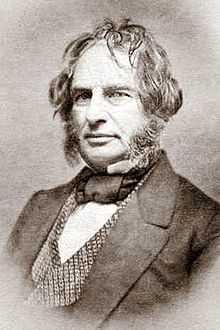The Wreck of the Hesperus

"The Wreck of the Hesperus" is a narrative poem by American poet Henry Wadsworth Longfellow, first published in Ballads and Other Poems in 1842.[1] It is a story that presents the tragic consequences of a sea captain's pride. On an ill-fated voyage in winter, he brings his daughter aboard ship for company. The captain ignores the advice of one of his experienced men, who fears that a hurricane is approaching. When the storm arrives, the captain ties his daughter to the mast to prevent her from being swept overboard. She calls out to her dying father as she hears the surf beating on the shore, then prays to Christ to calm the seas. The ship crashes onto the reef of Norman's Woe and sinks; the next morning a horrified fisherman finds the daughter's body, still tied to the mast and drifting in the surf. The poem ends with a prayer that all be spared such a fate "on the reef of Norman's Woe."
The poem was published in the New World, edited by Park Benjamin, which appeared on January 10, 1840. Longfellow was paid $25 for it.
Inspiration
Longfellow combined fact and fiction to create this poem. His inspiration was the great Blizzard of 1839, which ravaged the northeast coast of the United States for 12 hours starting January 6, 1839, destroying 20 ships with a loss of 40 lives.[2] He probably drew specifically on the destruction of the Favorite, a ship from Wiscasset, Maine, on the reef of Norman's Woe off the coast of Gloucester, Massachusetts. All hands were lost, one of which was a woman, who reportedly floated to shore dead but still tied to the mast.[3] It is, however, possible that this detail was taken from a different ship that foundered during the same storm. “The Wreck of the Hesperus” is based on two events: an actual shipwreck at Norman’s Woe, after which a body like the one in the poem was found, and the real wreck of the Hesperus, which took place near Boston. Despite that fact, the poem is so well known that the loop road leading close to Norman’s Woe from Route 127 is named Hesperus Ave.[4]
In December 1839, Longfellow wrote in his diary about the writing of "The Wreck of the Hesperus":
...suddenly it came into my mind to write [it], which I accordingly did. Then I went to bed, but could not sleep. New thoughts were running in my mind, and I got up to add them to the ballad. It was three by the clock. I then went to bed and fell asleep. I feel pleased with the ballad. It hardly cost me an effort. It did not come into my mind by lines, but by stanzas.[5]
In popular culture
"The Wreck of the Hesperus" was adapted into films of the same name in 1927[6] and 1948.[7] In the 1975 Australian film, Picnic at Hanging Rock, the headmistress forbids a student from participating in a school outing because she has failed to memorize lines from the poem. In Kevin Sullivan's 1985 film of Anne of Green Gables, a character recites "The Wreck of the Hesperus" prior to Anne's rousing rendition of "The Highwayman". "The Wreck of the Hesperus" is referenced in the comic song "Lydia the Tattooed Lady," by Harold Arlen and Yip Harburg, performed by Groucho Marx in the movie At the Circus (1939), by Virginia Weidler in The Philadelphia Story (1940),[8] by Robin Williams in The Fisher King (1991), as well as Kermit the Frog in The Muppet Show.
The title phrase is sometimes used colloquially to indicate a disheveled appearance. In the film The Big Circus (1959), one character tells another: "I didn't bring the rain and you're beginning to look like the wreck of the Hesperus."
The Pleasure Island amusement park in Wakefield, Massachusetts (1958 - 1970), 18 miles south-west of the site where the fictional Hesparus sank, featured a ride named "The Wreck of the Hesperus".[9]
The rock band Procol Harum included their song "The Wreck of the Hesperus" on their album A Salty Dog, released in 1969. George Harrison included his song "Wreck of the Hesperus" on his 1987 album Cloud Nine. The English poet Roger McGough recited a one-minute version of the poem, complete with sound effects, on the album "Miniatures" produced by Morgan Fisher in 1980.
The "Wreck of the Hesperus" features prominantly in Maryrose Wood's The Incorrible Children of Ashton Place: The Mysterious Howling where its perfomrance culminates in a squirrel chase and complete mayhem.[10]
Mad magazine parodied the poem by presenting the text with outlandish illustrations by Wallace Wood, including a pint-sized captain and a hideous, tall daughter, who survives the storms and strides away still tied to the mast.
Wreck of the Hesperus is the name of an Irish doom/drone metal band.
References
- ↑ Calhoun, Charles C. Longfellow: A Rediscovered Life. Boston: Beacon Press, 2004: 138. ISBN 0-8070-7026-2.
- ↑ Fitzgerald, Donal, "The Night of the Big Wind," Ice, Gales and Moving Bogs. Ballingeary Cumann Staire History Society Journal.
- ↑ North Shore Community College, "Norman's Woe (Gloucester Harbor) Location, History, and Legends," Poetry of Places in Essex County,
- ↑ http://myweb.northshore.edu/users/ccarlsen/poetry/gloucester/longfellow_hesperus.htm
- ↑ Calhoun, Charles C. Longfellow: A Rediscovered Life. Boston: Beacon Press, 2004: 139. ISBN 0-8070-7026-2.
- ↑ The Wreck of the Hesperus at the Internet Movie Database
- ↑ The Wreck of the Hesperus at the Internet Movie Database
- ↑ "Lyrics". The Philadelphia Story (1940). Reel Classics. Retrieved April 1, 2014.
- ↑ McLaughlin, Robert (2009). Pleasure Island. Arcadia Publishing. pp. 66, 83, 99. ISBN 978-0-7385-6460-9.
- ↑ Wood, Maryrose (2010). The Incorrible Children of Ashton Place. Harper Collins. pp. 218–224. ISBN 978-0061791055.
External links
| Wikisource has original text related to this article: |
| |||||||||||||||||
